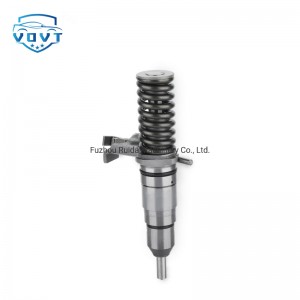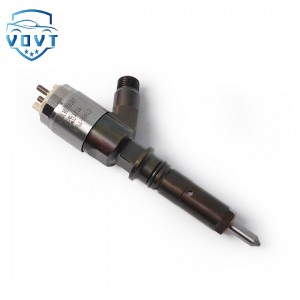New High Quality Diesel Injector 150-4453 162-8813 230-3255 246-1854 250-1302 250-1304 250-1308 250-1311 For CAT C3500B
Products Description
| Reference. Codes | C3500B |
| Application | C3500B |
| MOQ | 4PCS |
| Certification | ISO9001 |
| Place of Origin | China |
| Packaging | Neutral packing |
| Quality Control | 100% tested before shipment |
| Lead time | 7~10 working days |
| Payment | T/T, L/C, Paypal, Western Union, MoneyGram or as your requirement |
How to judge whether the pressure control mechanism of diesel injector is working properly?
To determine whether the pressure control mechanism of the diesel injector is working properly, it is necessary to combine fault phenomenon observation, instrument detection, component disassembly inspection and other multi-dimensional methods. The following are specific steps and key points:
Preliminary judgment through fault phenomenon
When the pressure control mechanism is abnormal, the engine usually has the following symptoms:
Insufficient power or poor acceleration
Insufficient pressure leads to poor fuel atomization, incomplete combustion, reduced engine power, and obvious weakness when climbing or accelerating.
It may be accompanied by black smoke (incomplete combustion of fuel) or white smoke (water in the fuel or extremely poor atomization).
Unstable idling or shaking
Pressure fluctuations will cause uneven fuel injection in each cylinder, obvious engine shaking at idle, and may even stall.
Difficult to start
During cold start, insufficient pressure will cause the fuel to be unable to be effectively atomized, and the engine will be difficult to start (especially in winter).
Abnormally increased fuel consumption
Excessive pressure may cause excessive fuel injection, incomplete combustion, and significantly increased fuel consumption.
Abnormal noise or vibration
If the spring of a mechanical pressure regulating injector is broken or stuck, it may make a "clicking" noise; if the solenoid valve of an electronic control type fails, it may be accompanied by abnormal vibration of the valve body.
Use professional instruments for detection
1. Fuel pressure test
Tools: Fuel pressure gauge (needs to match the pressure range of the engine fuel system, and the common rail system usually requires a high pressure gauge).
Steps:
Disconnect the injector inlet pipe and connect the fuel pressure gauge.
Start the engine and observe the pressure changes under idling and acceleration conditions:
Mechanical pressure regulating type: The pressure should be stable at the manufacturer's set value (such as 6-10MPa) at idle, and the pressure will rise slightly during acceleration, but the fluctuation should be less than 10%.
Electronic control type (common rail system): The rail pressure should be close to the target value (such as 100MPa) at idle, and the rail pressure will rise rapidly with the ECU command during acceleration (such as reaching 160MPa instantaneously), and the pressure fluctuation should be less than 5%.
Abnormal judgment:
Pressure is lower than the standard value: it may be that the pressure regulating spring is loose, the valve core is stuck, or the solenoid valve is leaking.
Pressure is too high and cannot be adjusted: it may be that the pressure regulating spring is too hard and the solenoid valve cannot be opened to relieve pressure.
2. Injector sealing test
Tool: Injector test bench (or use a fuel pressure gauge with a manual pump).
Steps:
Install the injector on the test bench and slowly pressurize it to slightly lower than the injection opening pressure (if the mechanical valve setting pressure is 10MPa, pressurize it to 9MPa).
Observe whether there is fuel leakage at the spray hole:
Normal situation: There should be no obvious dripping from the spray hole (allowed within 1-2 drops per minute).
Abnormal situation: Severe dripping or continuous oil leakage indicates that the needle valve sealing surface is worn, the pressure regulating spring fails, or the solenoid valve is not closed tightly.
3. Injection atomization test
Tool: Injector test bench or manual test after disassembly.
Steps:
Quickly pressurize to the injection opening pressure on the test bench and observe the fuel injection status:
Normal: The fuel is sprayed out in a fine mist, without obvious oil droplets or deflection.
Abnormal:
Poor atomization, oil droplets splashing: insufficient pressure or needle valve wear.
Injection deviation or individual nozzles do not spray oil: nozzles are blocked or needle valves are stuck.
4. Solenoid valve response test (electronic control type)
Tools: oscilloscope, diagnostic instrument (such as KT600, VCI, etc.).
Steps:
Connect the diagnostic instrument to read the ECU command signal, and use the oscilloscope to measure the solenoid valve coil voltage waveform:
Normal: After receiving the ECU signal, the solenoid valve should respond within 0.1-0.3ms, and the voltage waveform will have obvious pulses (such as the pulse peak value of about 9-12V in a 12V system).
Abnormal:
No voltage signal: ECU or line failure.
Signal but no action: The solenoid valve coil is open circuit, short circuit or the valve core is stuck.
3. Disassemble and inspect the pressure control components
If the instrument detects an abnormality, the injector needs to be disassembled to inspect the mechanical components of the pressure control mechanism:
Mechanical pressure regulating injector
Check the pressure regulating spring: whether it is broken, deformed or attenuated (the length or elasticity can be compared with the new spring).
Check the needle valve and valve seat:
Use a magnifying glass to observe whether the sealing surface has wear grooves, corrosion or carbon deposits (normally it should be smooth and undamaged).
Perform a "seal sliding test": take out the needle valve, lubricate it with clean diesel, and then vertically place it in the valve seat. The needle valve should be able to slide down slowly by its own weight (if it is stuck, it is abnormal).
Check the pressure regulating screw: whether it is loose (causing the preload to change).
Electronic control injector (common rail system)
Check the solenoid valve assembly:
Coil resistance: Use a multimeter to measure the coil resistance, which should meet the manufacturer's standards (such as the common value of 1-3Ω, if it is ∞ or 0Ω, the coil is damaged).
Valve core and valve seat: Observe whether there are impurities stuck, wear or rust (can be tested after ultrasonic cleaning).
Check the control piston and needle valve:
Is there any carbon deposit or metal debris in the control chamber (causing the piston to get stuck).
Whether the needle valve lift meets the standard (can be measured with a dial gauge, usually 0.2-0.5mm).
Verification by comparison or replacement method
Compare with normal parts: If there is a multi-cylinder engine, the injector suspected of failure can be swapped with the injector of the normal cylinder to observe whether the fault is transferred.
Replacement test: Install a new injector or pressure control component. If the fault disappears, there is a problem with the original component.
V. Precautions
Safe operation: The pressure of the common rail system is extremely high (up to 200MPa). Before disassembly, the pressure must be released to avoid personal injury caused by high-pressure fuel injection.
Clean environment: The disassembly process must be carried out in a clean environment to prevent dust from entering the injector and aggravating wear.
Data recording: Record pressure, waveform and other data during the test and compare with the manufacturer's maintenance manual to avoid misjudgment.
Through the above methods, the fault point of the pressure control mechanism can be systematically determined, and targeted repairs or replacement parts can be carried out. If you lack professional equipment, it is recommended to contact a diesel engine maintenance service provider.
























